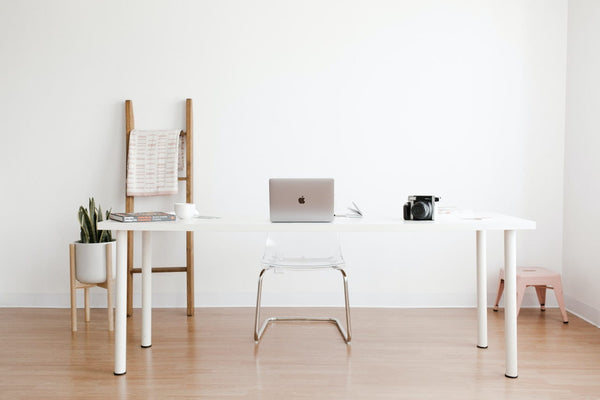The consequences of a not ergonomic workplace
Compared to other jobs, office functions initially seem much less burdensome for the body. Instead of operating heavy machines, moving heavy products or to stand their entire service in production lines or behind cash registers, office workers can sit at their desk most of their day. That is why you might think that office workers avoid the worst work -related physical burden.
However, this is not true. If you work at the office, chances are that you have back pain or know someone who has it. It is a common consequence of long services that are on an office chair. And it doesn't stop there - there are also headaches, painful shoulders, painful neck and more. Sitting for hours behind a desk can be uncomfortable, and if the desk, the chair or your posture is not suitable for the task, then that discomfort only gets bigger.
That is where office ergonomics plays a role. A good ergonomics in the office can help to keep employees happier, healthier and more productive. On the other hand, poor ergonomics in the office can cause permanent pain, reduce mental and emotional health and reduce the productivity of employees. But now you may wonder: what is office ergonomics?

What is office ergonomics?
Ergonomics refers to the design characteristics of an object or space that make it easier. This in particular refers to their ease of use -you would not describe a high -tech computer as an ergonomic because of the processing speed, but rather how the position of the monitor on the base made it easier to read.
OfficeGonomy are therefore the characteristics of an office space that facilitates its use. Ideally, the office furniture should be made and organized in such a way that it is as comfortable as possible for employees to use, and the employees themselves should use the correct posture and positioning to minimize the tax.
Ensuring good ergonomics is not only a matter of short -term comfort, although that should also be important. A poor office economy can lead to physical load and injury, increased stress and reduced work efficiency. Ergonomics that contributes to these factors is called ergonomic dangers. On the other hand, good ergonomics reduce physical and mental load and contributes to both the productivity and happiness of the employee.
Examples of ergonomic risks at the office
Ergonomic risks are everything that increases stress, tension or discomfort in the workplace - of course without tangible safety risks. There are three main types ergonomic dangers: environment, tools and behavior.
Environment
The greatest ergonomic danger at the office is not Ergonomic Furniture. Even if an employee has a perfect position and takes breaks to walk and stretch, a poorly fitting chair and a poorly positioned desk can lead to back pain, joint pain and more. A working environment without ergonomic dangers is easy and comfortable to use. Some examples of bad ergonomics in the area are:
- Old, worn or stiff office chairs
- Agencies without much space underneath or with poorly leveled sheets
- Remote office supplies, so that employees must constantly reach and reach it
- Excessive clear computer monitors or monitors that are placed for clear surfaces, such as windows that receive a lot of sunlight
- Tools
- The tools that your employees use can have just as much effect on ergonomics as the furniture. Although office spaces do not entail many heavy machines, even simple objects such as knives or non -machines can cause extra stress. Make sure your office supplies work well and are not outdated or poorly maintained.
Behaviour
A good working environment and good tools only work as well as the one who uses them. Although this is not as important at an office workplace as in a physically demanding job, it is important that your employees know how to properly perform their duties with an optimal physical form for long -term comfort. Even something simple if learning the right Til attitude for boxes can help in the long term. Some examples of ergonomically dangerous behavior are:
- Sagged in your chair
- Let your legs dangling above the ground
- Lean too close to your monitor
- Lifting heavy objects with an incorrect lifting shape
- Go without standing and walking for a long time

Consequences of poor officeGonomy
As mentioned, poor office gonomy does not only contribute to short -term discomfort. Over time, the consequences can accumulate and contribute to body pain, mental load and reduced work efficiency.
Physical complaints
Although it is true that an office job is physically not as demanding as a heavy work position such as construction, poor office energy -wonomy can still have a noticeably adverse effect on your physical health.
Backache: Many office workers are susceptible to poor posture, but sitting poorly for hours or in a chair that is not supported, can lead to weakened back muscles and back pain. In severe cases, this can even have an adverse effect on the spine.
Effect on organs: Apart from the effect it can have on the spine and back muscles, poor posture can also compress the lungs and stomach. In a longer period of time this can lead to respiratory difficulties and stomach pain.
Neck and shoulder pain: Being bent to a desk and having to reach repeatedly to things can lead to shoulder pain. Moreover, it can constantly stretch or turn the neck to neck pain.
Headache: Focusing on a clear screen for several hours or on small details can lead to more headache and tired eyes. Long -term tired eyes can even lead to blurry or double vision.
Wrist pain: Constant types and poor type attitude can cause wrist pain. It can especially lead to Carpal tunnel syndrome, that comes from a pinched nerve in the wrist and can cause both pain and numbness.
Joint pain: Long -term sitting can lead to joint pain, especially in the knees.
Poor blood circulation: Sitting for a long time can lead to poor blood circulation. In severe cases this can lead to varicose veins - twisted and visible veins, usually in the legs, which may or may not be harmful.
These problems can be reduced or exacerbated, depending on a person's attitude, but they are all aggravated by poor office ergonomics.
Mental load
Poor office energy -wonomy can also mentally burden employees. Sitting for a long time, the energy level reduces due to the influence of poor posture on the cardiovascular and metabolic system. In combination with the physical pain that is often accompanied by long office hours, this can lead to a bad mood and increased stress.
Reduced efficiency
With both increased physical pain and mental stress, it is no surprise that poor officeGonomy can contribute to reduced work efficiency. In addition, lower energy and low productivity can contribute to burnout, which further damages both the productivity and the emotional condition of the employee. This creates a negative feedback job of decreasing productivity, which leads to a reduced mental state, which leads to a further decrease in productivity.
Tips to improve office gonomy
There are two factors that can be changed to improve the ergonomics of the office: the furniture and tools itself, and the positioning and behavior of employees during their use. Here are a few tips that employees can use to improve their work experience:
Unintelligent: Shallig exerts unnecessary pressure on your internal organs and the discs of your spine. Make sure you sit upright in your chair and that your loins are well supported.
Walk when you can: Getting up and walking, even if it is only short, can help improve your blood circulation and burden your back a little less. Don't forget to get up and walk a few times during the working day to let your blood flow.
Support your arms: If you constantly let your arms hang, your neck and shoulder muscles are heavily loaded. Keep your arms supported when you can, whether it is on the armrests of your chair or on the leaf of your desk.
Place your monitor directly for you: If you have to stretch your neck to properly view your monitor, the neck tax increases. By keeping your monitor straight in front of you and not placing too high or too low, you can reduce the load on your neck. Make sure the keyboard is right in front of you to prevent your shoulders from being overloaded when constantly turning and adjusting.
Hold the phone: Keep your phone in your hand when you use it. If you clamp it between your ear and shoulder, you may have your hands free, but if you hold it there, neck and shoulders will be burdened. If you prefer to have your hands free, consider looking at wireless telephone gates.
Hold the mouse and the keyboard close together: Keep the keyboard and the mouse close together to prevent you from constantly grabbing to one or the other. This will help reduce the load on your wrists and shoulders.
Keep your head straight: Keep your head straight and evenly while you work. Forward or stretching backwards will burden your neck muscles and lead to a headache.
Keep the monitor remotely: Leaning too close to the monitor can burden your eyes and cause a headache. Make sure it is close enough to be able to read comfortably, but not closer.
Reducing sparkle: Staring for a long -term screen for a clear screen can burden your eyes and cause a headache. Limit the sparkle of your monitor and make sure that it is not placed for a brightly lit surface, such as a sunny window.
Give your eyes a break: Occasionally look away from your screen for something neutral in the distance. Even if it's for a few seconds, it can help to reduce tired eyes by giving your eyes a break of your monitor.
Don't let your feet dangling: Make sure your feet can rest flat on the floor. If your chair is too high and they cannot reach it, buy a footrest or a low stool to rest.
Some of these options are easier or more difficult to implement, depending on your workspace. Even if you can only use a few, it can still help to improve your physical and mental state, as well as your work efficiency.

Ergonomic office furniture
Apart from the behavior of employees, the best way is to improve the ergonomics in the office, to adjust the office itself. Poor fitting office chairs and desks can force employees to bend or turn, which increases the discomfort and wors physical injury. To improve the physical, productivity and mood of the employee, it is important to have comfortable - and preferably adjustable - furniture. For an office building, the most important furniture is the chairs and desks in this respect.
Office chairs
Office chairs are an important part of the daily life of every office employee. They work with it for most of the day, so it is important that the seats are ergonomically responsible. Poor office chairs have no adjustment options and do not support the lower back. An ergonomic office chair must promote an optimal attitude, support the lumbar region and be adjustable to take into account the different physique of the employee. Here are, for example, some of the functions offered by the ergonomic office chairs of work:
Mobile: Our seats are equipped with rolling wheels and 360-degree turns, so that employees can switch quickly and smoothly between work environments.
Height settings: With our seats you can adjust the height of the seat, which means that you can switch between table heights without sacrificing or exchange your comfort for a new chair.
Tilt function: Our seats can tilt both forwards and backwards, so that you can keep your feet firmly on the floor and your hips at an optimal angle to prevent voltage.
Armrests: Our ergonomic seats are always provided with armrests to relieve your shoulders. Different models have adjustable height and orientation.
Headrests: Our office chairs with high backrest have both removable and built -in headrests. These support the head and neck when the chair leans back.
Locking mechanisms: The locking mechanism of our seats ensures that your settings are stored every time you adjust them. In this way you can return to the same seat preferences every day, instead of having to set the chair again and again when you return to it.
Agencies
Although an office chair is important, an agency is that, especially when this is the first that someone sees as soon as he enters an office. An ergonomic agency must look both good and encourage a good working posture. Workliving offers traditional desks in different styles, as well as standing agencies. Stand agencies help relieve neck and joint pain, allow the blood to flow and encourage employees to be more active in the workplace.






Ik werk op kantoor en we hebben een werk tafel met meerdere collega’s en die kan je niet instellen. Ik merk dat die werktafel aan de lage kant is waardoor ik vaak rugpijn hebt. Ik heb dit vaak doorgeven aan de werkgever maar er valt niks aan te doen.
Heeft uw verder tips?
Met vriendelijke groet,
Laura Duffels
Ik werk op kantoor en we hebben een werk tafel met meerdere collega’s en die kan je niet instellen. Ik merk dat die werktafel aan de lage kant is waardoor ik vaak rugpijn hebt. Ik heb dit vaak doorgeven aan de werkgever maar er valt niks aan te doen.
Heeft uw verder tips?
Met vriendelijke groet,
Laura Duffels
Ik werk op kantoor en we hebben een werk tafel met meerdere collega’s en die kan je niet instellen. Ik merk dat die werktafel aan de lage kant is waardoor ik vaak rugpijn hebt. Ik heb dit vaak doorgeven aan de werkgever maar er valt niks aan te doen.
Heeft uw verder tips?
Met vriendelijke groet,
Laura Duffels